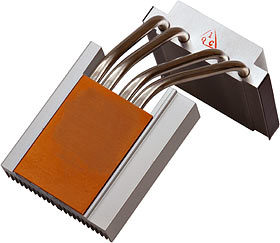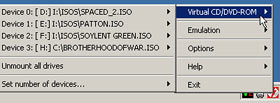
Atomic I/O letters column #62
Originally published in Atomic: Maximum Power Computing Reprinted here October 2006.Last modified 16-Jan-2015.
Left foot on... yellow!
I have heard that when you're installing a CAT5/5E/6 network anywhere, when you're terminating into sockets on your wall (or comms cabinet), you should leave as many twists in the pairs as possible where you punch down.
This is supposed to give you better performance than if you untwist back to the outer insulation.
What I wanted to know was - is it significant?
Steven
Answer:
Plain unshielded multi-conductor wire is not meant to be able to transmit high bandwidth signals over a significant
distance. It took us humans a while to figure out how to trick it into doing so. Before we did, high bandwidth always
meant coaxial cable.
The separate twisted pairs in Unshielded Twisted Pair cable look kind of haphazard if you strip off a length of the insulation, which encourages people who're wiring an office (or just saving a few bucks by making their own network cables) to think that it's OK to straighten some wire out to make it neater at the plug (or wall socket, or patch panel) end of a cable. The messiness of the twists (or "lays") is by design, though. They're deliberately made to be different lengths to evenly reduce crosstalk between conductors, and external noise reception, at various frequencies.
You don't wreck a twisted pair cable's noise and crosstalk resistance if you untwist a couple of inches of it at the ends, but you do significantly hurt the cable's signal transfer ability, which can easily result in data transmission errors.
A marginal cable may work OK in a network - indeed, many networks past and current have some dreadful wire and/or connections in there - but transmission errors will make things slower at best, and can occasionally actually result in uncorrected flipped bits in transferred data.
Much more importantly, they can hurt performance in things like online games, when you're using a protocol like UDP that doesn't have any error correction!
Because of the haphazardness of the twists in UTP cable, though, it's easy to avoid these problems even if the cable untwisted when you stripped it and got it ready to be punched down. Just identify the pairs in the stripped cable, and put another twist or two in 'em on the way to the contact block before you punch down. Problem solved.
10W-40 computing
I was reading about the "Oil PC" featured in a previous edition of Atomic, and I was wondering, can you use mineral oil in a water cooling system instead? You know, just in case there IS a leak, my box won't get fried.
William
Answer:
Yes, but if there's a leak and a spark, it'll burn your house down!
Actually, oil cooling would be feasible, with some caveats.
First: Oil, like most other Brilliant New Coolants that people think of, isn't anywhere near as good at transferring heat as water. Since a lot of water cooling systems have plenty of extra capacity, though, this isn't necessarily a big problem.
Second: You'd have to change a few parts.
Silicone rubber tubing will be eaten by oil, so you'd have to change to Tygon or something if you want nice soft tubing - though cheap PVC would probably be OK. A water pump won't be able to move the much more viscous fluid, so you'd have to switch to one that can - maybe a peristaltic pump. Anything that restricts water flow a lot will restrict oil flow a whole lot, but modern "open" water blocks will probably be OK.
Given that leaks in water cooling systems are (a) not hard to avoid and (b) often not actually terribly dangerous - you just shut the computer down, wash any damp parts with demineralised water, dry somewhere warm and hope for the best - there's not a lot of reason to do this.
But, y'know, who needs a reason?!
Liquid sodium would rule
As most Atomicans know, heat pipes are fluid-filled vessels that are very effective at transferring heat away from a given spot. I'm just wondering, what *is* this magic fluid inside the heat pipes? It must be some special stuff with an excellent specific heat capacity in order to absorb all that energy in an efficient manner.
Michael

As with golf balls, I regret to say that there's
probably nothing very interesting inside.
Answer:
Heat pipe fluid does indeed need to have good thermal qualities. High
latent heat of vaporisation is important, so that the fluid
absorbs plenty of energy as it turns into a gas and heads for the cold end of the pipe (heat pipes aren't actually
filled with their working fluid), but there are various other requirements.
Heat pipe fluid mustn't react with, or seep through, the material the heat pipe's made from. It mustn't change qualities unacceptably when hot or cold. It must "wet" the wick and/or wall of the heat pipe properly - otherwise the pipe will only work when it's vertical. It needs pretty stable vapour pressure over the intended temperature range - too little pressure and the pipe stops working; too much and a lightly built pipe could leak. It needs low viscosity in liquid and gas states, it needs high surface tension (without which capillary action doesn't work), and it needs not to freeze in the operating temperature range.
All of those requirements have led to various more or less exotic fluids being used in heat pipes made for different temperature ranges. Helium, nitrogen and ammonia for super-cold, very cold and cold pipes, respectively; sodium, lithium and silver at the other end of the temperature graph. Methanol, ethanol and acetone all work OK for computer-ish temperature ranges - below 10 to above 100 degrees C. And acetone's hell on plastic but fine with metal, so it'd be an excellent choice for low cost heat pipes made from uncoated copper, if not for the existence of... water.
Water has ticks in all the right boxes for use in the computer-cooling temperature range, which is why people use it in liquid cooling rigs. And it's harmless to humans, which can't be said for acetone, and it won't eat copper (though I must try this) and so can be used in cheap copper heat pipes. Water expands when it freezes, but there's lots of room for it to do that in a heat pipe, and a pipe that's cooling a chip doesn't need to start working until it's warmed up well past freezing anyway.
I'm not sure what proportion of the heat pipes used to help cool consumer electronics contain water, but I'll betcha it's most of them.
As easy as 1, 2, 7.276371092...
I have been tearing my hair out over a so-called "easy to install", "plug and play" USB to IDE adapter. When I connect it up the result is no USB Mass Storage device in my computer. I have ripped out the USB in Device Manager and restarted the PC so Windows rebuilt it. Tried it in Windows XP and 2000. Also tried 3 different hard drives. It keeps installing an "AVX CD/DVD-ROM SCSI CdROM" device, which appears in Device Manager. Are there any drivers required for these things?
Brian

Virtual drives don't usually cause trouble, and mounting your rips of your DVDs can save wear and tear
on the real drive!
Answer:
That device name is what Alcohol 120% calls its virtual CD/DVD devices
- you know, apparent "drives" that're actually image files on disk. So my first guess would be that something in the
Alcohol installation is screwed up, or you're seeing the Alcohol device and mistaking it for a new device created
by plugging in the USB adapter. Which could just be stone dead.
If you're seeing the AVX device name on machines that don't have Alcohol installed, then you're into the Twilight Zone.
I haven't seen this problem myself, either, but I use Daemon Tools for my virtual drive needs.
(Brian got back to me. Uninstalling Alcohol did, indeed, solve the problem.)
Road warrior
What is the best mobile graphics chipset available at the moment?
I understand about the price vs performance issue, and thus that the 3rd-most-expensive chipset would be the best, so a single response is all I'm after - I trust you THAT much!
Kevin
Answer:
You'd think it'd be easy to answer this question. Just compare the fastest mobile chips from the only two players
in this game - which were the ATI Mobility Radeon X1600 and the Nvidia GeForce Go 7800 GTX, when I first wrote this.
The joker in the pack, though, is that most people don't plug laptops into external monitors, so you're usually stuck with the resolution of the standard screen. That's probably not going to exceed 1920 by 1200, and may be considerably lower. The screen also isn't going to be bigger than a 17 inch diagonal, unless you've managed to get hold of one of those super-aircraft-carrier ("nuclear carrier"? "CVN"?) 19 inchers.
(Or, of course, that Dell thing. Which only has 1650 by 1050 screen resolution, anyway.)
Super resolution on a small screen means high FSAA levels are pretty much pointless unless you're determined to use your laptop at migraine-inducing distances. Lower resolution, on a screen of any size, results in a similar rendering load even including high FSAA.
What all this means is that the monstrous pixel painting rates of the current top level mobile chips won't necessarily be used, unless you wind up all of the sliders past the point where you can actually see a difference.
Nvidia and ATI have both announced a couple of speed-bump chipsets past the Go 7800 GTX and the Mobility Radeon X1600, but you can't have either of them in many laptops yet. The 7800 GTX is faster than the X1600, and more widely available since it hit the streets earlier (recently, Nvidia's been better than ATI at actually having chips to sell when they "release" them). But either should be more than adequate.
Actually, unless you plan to use an external monitor or peer very closely at a tiny-pixelled 1920 by 1200 laptop, you'd probably be very well pleased with an adapter at least one notch slower, provided the computer had the other stuff you wanted.
The other 44 versions didn't work
Thank you for your article "Networking Explained". As a Computer Admin. student I found it well written, humorous, informative, and generally a worthwhile read.
Inquiring minds want to know what the "45" in RJ-45 means. Or, for that matter, the "11" in RJ-11?
Carol
Answer:
Sorry to be a wet blanket, but it stands for nothing in particular. It's just the number
Ma Bell was up to when she wrote that Universal Service Order
Code (USOC, pronounced "you-sock").
Or, as seems more likely, when a nameless swirl of primal chaos vomited forth that section of the Code into our universe.
More info on Wikipedia here.

